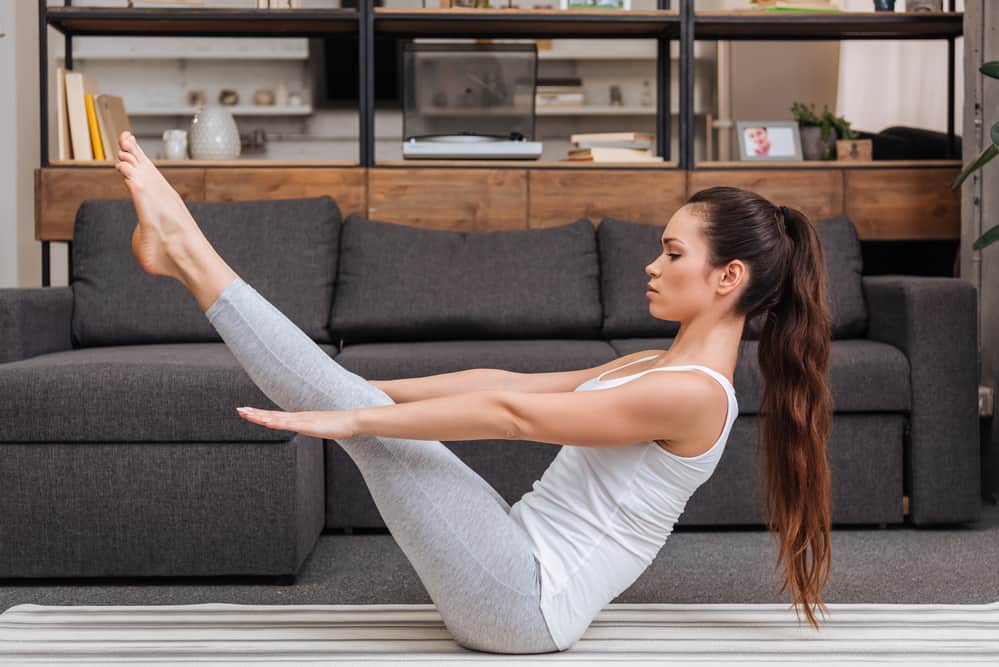Improving balance with basic yoga poses strengthens the core muscles and stabilises the body. This helps to reduce the frequency of falls and injuries.
A regular yoga practice strengthens the muscles of the body and increases the range of motion in the joints. Having strong core muscles helps to stabilise the body, preventing falls. Increased range of motion in the joints reduces the chances of serious injury should a fall occur. Practising basic yoga poses a few times a week is a good starting point for finding more stability and strength.
Contents
Tadasana (Mountain Pose)
Purpose
Standing in Tadasana brings the entire body into alignment and increases awareness in all parts of the body. Tadasana is a chance to observe neutrality in the body. When the body is standing in neutral, it becomes possible to notice habits or areas of weakness in the body that could contribute to poor balance.
Positioning
If the balance is a challenge, stand near a wall or a chair. Begin with the feet a few inches apart, as balance improves the inner edges of the feet will come together. Press down evenly through both feet and firm the fronts of the thighs. Draw the belly gently in and up to tone the core muscles and allow the lower back to lengthen.
Extend up through the sides of the waist and let the arms hang by the sides of the body. Move the heads of the shoulders back until they are in line with the sides of the body and extend up through the crown of the head. Stay in tadasana and breath easy, with the gaze focused, but the muscles around the eyes relaxed, for one to two minutes.

Navasana (Boat Pose)
Purpose
Navasana is a pose to strengthen the deep core muscles, creating more stability through the centre of the body. The deep core muscles support and control the lower body and the pelvis and help provide structure to the spine. Strength in the core not only creates stability but helps to reduce compression in the lower back that leads to lower back pain.
Positioning
Begin by sitting with the knees bent and feet flat on the floor. Place the hands loosely behind the knees and rock onto the sitting bones, keeping the chest lifted and the spine long. Maintaining a long spine begins to extend the arms forward. If straight arms are maintained with ease, begin to straighten the legs to bring the body into a “v” shape, lifting out of the lower back and keeping the weight on the sitting bones. Begin with two repetitions of this pose, holding for five breathes each and moving to five repetitions.
Vrksasana (Tree Pose)
Purpose
Tree pose challenges the balance of the body as well as opens the hips. When first beginning, it is best to practice this pose near a wall. Balancing on one foot in poses such as tree pose helps to strengthen the core and stabilize the muscles surrounding the spine. By focusing the eyes on one place and listening to the breath, tree pose helps the mind to focus and become more balanced as well.
Positioning
To come into the Vrksasana (tree pose), begin in tadasana (near a wall if balance is an issue). Bring the right foot to the inner left thigh, releasing the right knee out to the right. The rest of the body is still in tadasana, the standing leg is straight, and there is the length in the torso from extending up through the crown of the head. Begin with the hands at the heart centre (or one hand on a wall), and for an extra challenge, take the arms up alongside the ears, palms facing each other so the sides of the neck can release.
For added stability, press the lifted foot to the inner thigh and the inner thigh to the foot, activating the leg muscles. Stay inside one for five breaths, then return to tadasana and move to side two.














No Comments